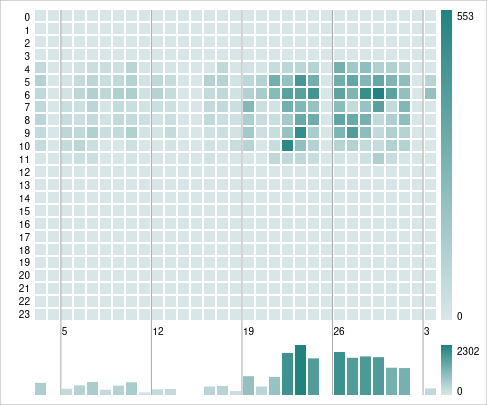quazardous / activity-heatmap
A d3 heatmap for representing time series data
Installs: 67
Dependents: 0
Suggesters: 0
Security: 0
Stars: 8
Watchers: 1
Forks: 2
Open Issues: 0
Language:JavaScript
Type:component
Requires
README
A(nother) d3.js heatmap representing time series data. Inspired by Github's contribution chart
Inspired by the excellent DKirwan's Calendar Heatmap.
Reworked for d3.js v5 + ES6 class style.
Screenshot
Yearly profile.
Monthly profile.
Features & specs
- Heatmap
- Histogram
- Labels and scales
- Free time granularity
- Clean coding... (well tell me)
- Easy to tweak with options and profiles
- Fully localizable (uses only
moment.format())
Dependencies
Usage
-
Add
d3.jsandmoment.js -
Include
activity-heatmap.js<script src="path/to/activity-heatmap.js"></script>or<script src="path/to/activity-heatmap.min.js"></script> -
Add style stuff for tooltips
.heatmap-tooltip { position: absolute; z-index: 9999; padding: 5px 9px; color: #bbbbbb; font-size: 12px; background: rgba(0, 0, 0, 0.85); border-radius: 3px; text-align: center; }
-
Add some container
<div id="my-heatmap"></div> -
Create the heatmap with some data
d3.json("url/to/my-data.json").then(function(data) { // do your AJAX stuff here data.forEach(function(d) { // final data items should have at least a JS Date date... d.date = new Date(d.timestamp); // ...and a Number value. d.value = +d.value; }); const map = new ActivityHeatmap(data, 'yearly', '#my-heatmap'); map.render(); });
Options
The second arg is a profile hint that will tweak options. You can override the tweaked options after instantiation.
The third arg can be an extensive options object.
const options = { selector: '#my-heatmap' }; const map = new ActivityHeatmap(data, 'yearly', options); map.options.period.from = new Date('2020-01-01');
Final computations will be done at render time.
Here is some common options:
const options = { debug: false, selector: "#monthly", legend: true, histogram: true, frame: true, colors: { separator: "#AAAAAA", frame: "#AAAAAA", scale: ["#D8E6E7", "#218380"] } };
Inline render()
render() can be use without arguments or you can pass your own SVG object.
... const heatmap = map.render(mySvg, 100, 50); ...
It returns a SVG group with the whole heatmap.
Example
Open examples/ex1.html.
NB: if you open ex1.html as local file, you may need to bypass CORS (With FF: about:config > privacy.file_unique_origin => false).


